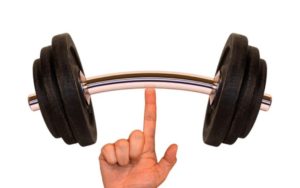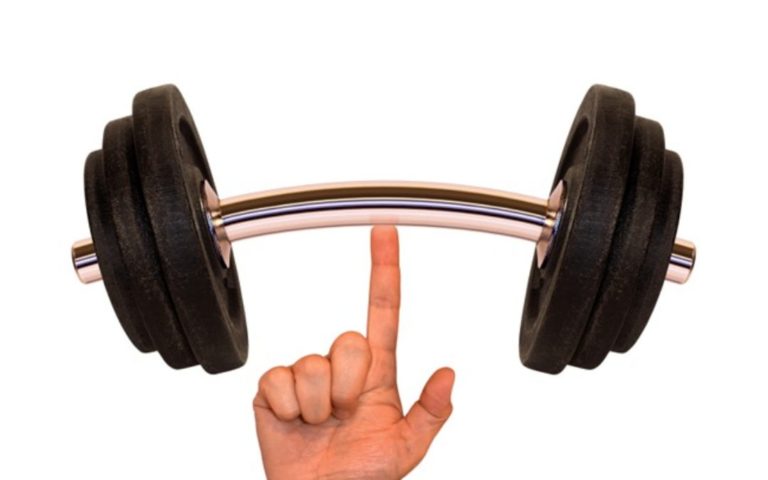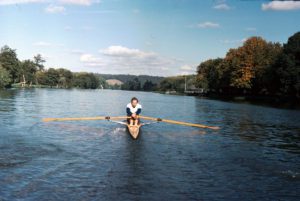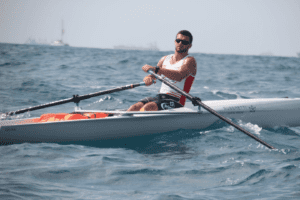How to become a stronger rower: Part 4. Strengthening by Weight-training. The fourth part of our series about how you can become a stronger rower!
Missed the first parts of this blog series? Here are Part 1, Part 2 and Part 3. Enjoy your workouts!

Strengthening by Weight-training – The Big brother of Glute Bridge
After understanding and activation, it is time to move to strengthening. I believe that this is best done through weight-training. The common idea of strength training for hip extensors revolves somewhere around deadlifts, squats and cleans. These exercises indeed do require hip extension, and thus strengthen the glutes. These lifts are prevalent amongst rowers, and rightly so. However, for someone with trouble activating their glutes these exercises end up stressing the wrong muscles, the correct execution of these lifts is near impossible, and injury risks are considerable. People with weak glutes end up compensating with their lower backs (much like in rowing). A better way to begin training hip strength is the big brother of glute bridge: the hip thrust.
This exercise is much like the glute bridge and most of the advice is the same. The obvious differences being that a barbell is used to add challenge to the exercise, and that the back is supported against a bench instead of the ground to allow greater range of movement. I won’t repeat the advice already given just apply the idea of the glute bridge to this movement. Some things, should be said though. First, start relatively light with the weight, body weight or just the barbell. Keep on progressively adding weight until you find a weight where you cannot properly hold the lift at the top for a couple of seconds with hips in full extension ,which means a slight overextension (ie. your body parallel to the ground with your pelvis a centimeter or two higher than your shoulders). Take 5 to 10kg off this weight or somewhere in the region where you are able to perform 10 repetitions with correct form. Be honest with yourself, it is easy to load masses of weight on this exercise and end up using your entire body to lift the weight instead of your glutes. Ultimately your aim should be to lift a good deal of weight, but to reap the benefits check your ego and start low. Second, make sure that the bench or whatever you are supporting your shoulders against is firmly supported against something to prevent it from moving. It shouldn’t move if you’re performing the exercise correctly (if it moves you’re pushing backwards instead of upwards), but it never harms to be safe. Third, supporting your back against the bench can be tricky. I recommend propping your back against the bench on a level where the bench is just below your armpits. Finally, push through your heels, squeeze your glutes and hold at the top.
I usually programme hip thrust for strength and development of neural activation of muscle. Therefore, I prefer using somewhere in the region of 3 to 6 repetitions per set and 3 to 5 sets. 3 sets of 5 is a good way to start. The low number of repetitions allows for each repetition to be performed correctly. Once you’ve mastered the movement you can use longer sets (8 to 12 reps) for muscle growth and really feeling the burn in the glutes. This can also be achieved through longer holds at the top, a good way to finish the exercise is to slowly count down from 10 whilst holding the weight at the top. With strength as the main goal (as it should be for rowing), keep the repetitions low and add weight.
Want more glutes training?
For further ideas about training your glutes google Bret Contreras, his research on the topic is invaluable. Once you’ve mastered the hip thrust, I recommend going to the big lifts: deadlift and squat. I won’t go into detail about them in this post, as I feel I’m already straining your attention span.
Don´t forget to implementing your new knowledge and training in the boat
With that said, I have a couple more things to add, but I’ll be brief and to the point. First, the point of this article was to give advice on how to become a stronger rower. After understanding, activating and strengthening it is time to go back into implementing your newly found hip drive into rowing. Whether on the boat or on an erg you should make it your priority to crush the footplate at the middle of the drive. In doing so, be sure to push through your heels and swing through your hips. Activating and strengthening revolved around pushing through your heels and so should it in rowing.
Second, it is impossible to implement full hip strength with a rounded lower back. Stay upright in the boat, rock over from the hips on the recovery, and reverse this movement on the drive. I leave further advice about rowing technique to others. Achieving good hip and back position requires flexibility from your hamstrings and your hip flexors. I recommend stretching these muscles daily. Short dynamic stretches during the warm-up. Longer static stretches performed on their own (with at least a couple of hours after your last proper session). Increasing flexibility requires about 2 to 5 minutes of stretching the muscle per day so not much, especially as I am prescribing only 2 stretches. So for both legs this takes only 20 minutes per day. Easy to achieve in the evening when watching TV or just relaxing, no excuses. Hamstring inflexibility leads to compensating with your lower back thus exposing you to lower back injuries in addition to inhibiting your hip drive and ultimately boat speed. I recommend stretching whilst lying on your back (to make sure your back stays straight). Through a towel or a rubber band around your foot and raise your leg upright until you feel a nice stretch. Don’t stretch to pain! The second stretch should concentrate on your rectus femoris and iliopsoas (hip flexors). For this assume a half kneeling position with your rear foot supported against a bench or something similar (your hand will do). From this position push your hips forward until you feel a stretch ranging from your quadriceps to your pelvis.
I hope you enjoy the exercises and are able feel the improvements of a strong hip when you’re back in the boat!
A guest post by Elias Lehtonen







